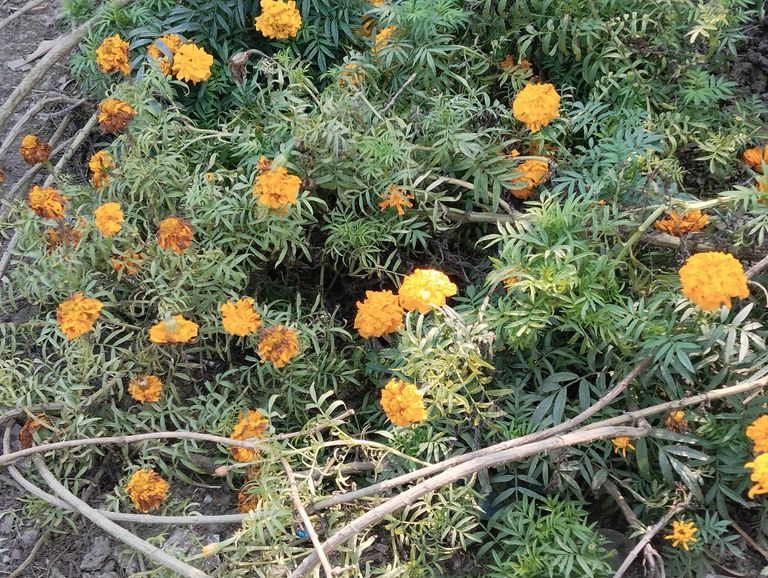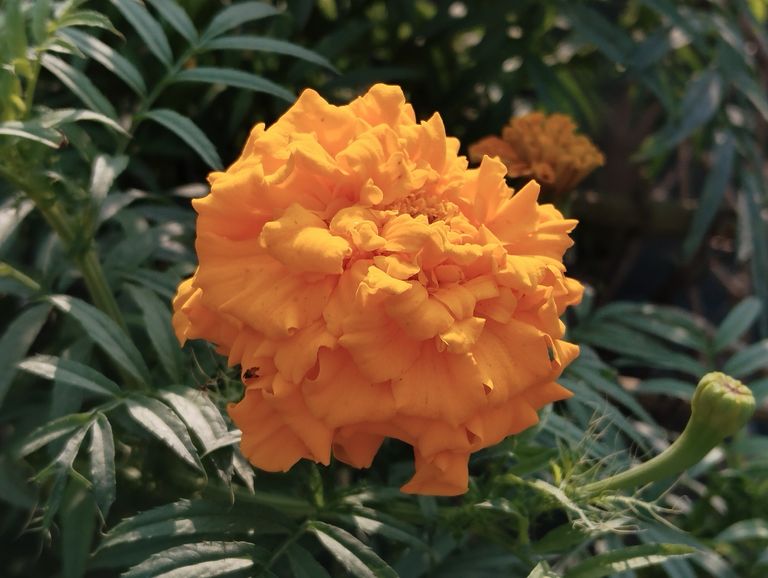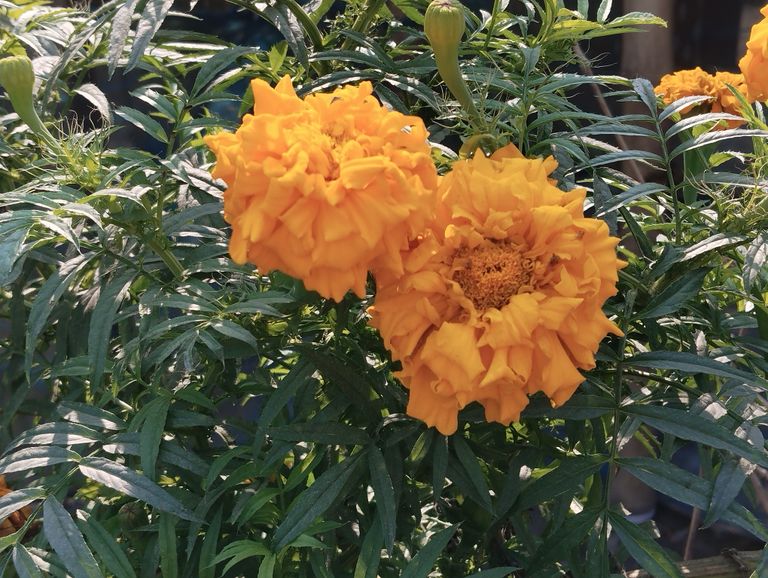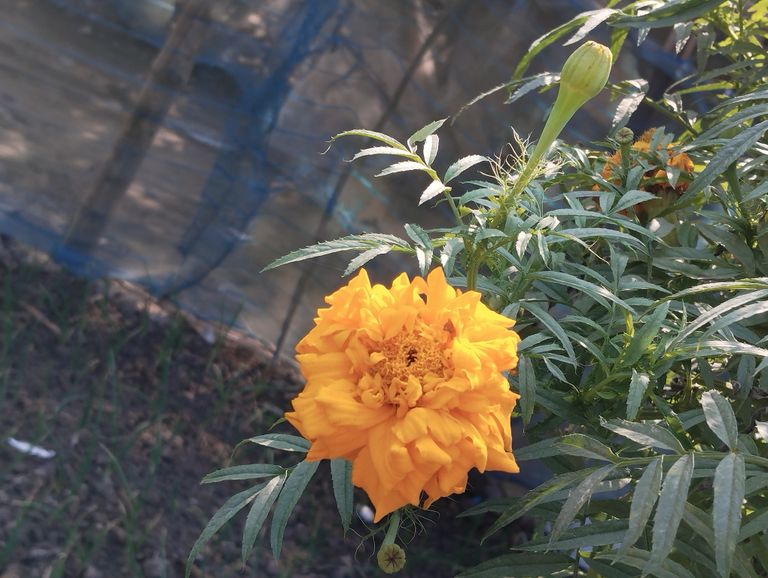
Marigold Garden A Vibrant Addition to Your Space.
Marigolds, also known as genda phool in many parts of South Asia, are among the most vibrant and easy-to-grow flowers. Known for their rich orange, yellow, and golden hues, marigolds can transform any garden into a lively and cheerful space. Whether you're a seasoned gardener or a beginner, cultivating marigolds can be a delightful experience. This blog will guide you on how to create and maintain a flourishing marigold garden while exploring its benefits and cultural significance.
Why Choose Marigolds for Your Garden?
Marigolds are not just beautiful; they are also incredibly versatile and beneficial for gardens. Here’s why they are a must-have:
- Easy to Grow: Marigolds thrive in a variety of climates and soil types, making them ideal for beginners.
- Pest-Repellent: These flowers are natural insect repellents. Their strong scent deters pests like aphids, mosquitoes, and nematodes.
- Cultural Importance: In countries like India, marigolds are used extensively in festivals, religious rituals, and decorations.
- Attract Pollinators: Marigolds attract bees and butterflies, which are essential for pollination in your garden.
- Low Maintenance: With minimal effort, marigolds provide maximum impact in terms of color and vibrancy.
Types of Marigolds
Before planting marigolds, it’s essential to know the different varieties. The most common types include:
- African Marigolds (Tagetes erecta):
Tall and bushy plants with large blooms.
Perfect for garden beds and borders.
- French Marigolds (Tagetes patula):
Compact and smaller in size.
Ideal for containers and small spaces.
- Signet Marigolds (Tagetes tenuifolia):
Delicate, lacy foliage with small, edible flowers.
Often used as garnishes or in salads.
- Calendula (Pot Marigolds):
Although not true marigolds, calendulas are often grouped with them.
Known for their medicinal properties.
How to Grow Marigolds: Step-by-Step Guide
- Choosing the Right Spot:
Marigolds thrive in full sunlight. Choose a location that gets at least 6-8 hours of direct sunlight daily.
- Preparing the Soil:
Use well-draining soil rich in organic matter.
If the soil is clay-heavy, mix in compost or sand to improve drainage.
- Sowing the Seeds:
Marigold seeds are easy to handle and germinate quickly.
Sow the seeds about 1/2 inch deep and space them 6-18 inches apart, depending on the variety.
- Watering:
Water the plants regularly but avoid overwatering. Marigolds prefer slightly dry conditions.
- Fertilizing:
Use a balanced fertilizer once every month during the growing season. Avoid nitrogen-heavy fertilizers, as they promote foliage over flowers.
- Deadheading and Pruning:
Regularly remove wilted blooms to encourage new flowers and maintain the plant's health.
Prune the plants lightly if they become too bushy.
Caring for Your Marigold Garden
- Pest and Disease Control:
Marigolds are naturally pest-resistant but can sometimes be affected by powdery mildew or spider mites.
Use organic neem oil spray as a preventive measure.
- Companion Planting:
Pair marigolds with vegetables like tomatoes, cucumbers, and beans. Their pest-repelling properties protect these crops.
- Seasonal Care:
Marigolds bloom best in the warm seasons of spring and summer.
In colder regions, you can grow them indoors in pots.
Benefits of Growing Marigolds
- Aesthetic Appeal:
Marigolds add a pop of color and liveliness to any garden or balcony.
- Air Purification:
Like most plants, marigolds improve air quality by filtering toxins.
- Medicinal Uses:
Calendula, a type of marigold, is known for its healing properties. Its extracts are used in ointments for skin ailments.
- Cultural and Spiritual Significance:
In many cultures, marigolds are considered auspicious and symbolize positivity and prosperity. They are commonly used in garlands, rangolis, and decorations during festivals.
Creative Ideas for a Marigold Garden
- Border Designs:
Use African marigolds to create vibrant borders around your garden or walkway.
- Container Gardening:
Plant French marigolds in colorful pots and place them on your balcony or patio.
- Mixed Flower Beds:
Combine marigolds with other flowers like petunias, zinnias, or salvia for a stunning mix of colors.
- Hanging Baskets:
Use compact varieties like signet marigolds for hanging baskets to add a decorative touch.
Creating a marigold garden is an enriching experience. These cheerful, low-maintenance flowers not only beautify your space but also offer ecological and cultural benefits. Whether you plant them in a sprawling garden or a small balcony, marigolds will brighten up your surroundings and your mood.

The Benefits of Marigold Leaves: A Natural Remedy for Health and Wellness
Marigold, scientifically known as Tagetes, is a vibrant flowering plant that is widely recognized for its ornamental beauty and cultural significance. While the flowers often take center stage in gardening and traditional rituals, the leaves of the marigold plant also hold immense potential due to their medicinal and therapeutic properties. For centuries, marigold leaves have been used in traditional medicine systems, including Ayurveda and folk remedies, for their health benefits. In this blog, we’ll delve into the various uses and advantages of marigold leaves, exploring how this humble plant can support our well-being.
- Rich in Antioxidants
Marigold leaves are packed with natural antioxidants that help combat free radicals in the body. Free radicals are unstable molecules that can cause oxidative stress, leading to aging and chronic diseases. The antioxidants in marigold leaves can:
Protect cells from damage.
Reduce the risk of chronic diseases like cancer, diabetes, and heart conditions.
Promote overall skin health and slow down signs of aging.
- Anti-inflammatory Properties
The bioactive compounds in marigold leaves possess powerful anti-inflammatory effects. These leaves can be used to:
Alleviate swelling and redness caused by minor injuries or insect bites.
Reduce joint pain and inflammation, especially in conditions like arthritis.
Ease symptoms of inflammatory skin disorders such as eczema and psoriasis.
- Natural Antimicrobial Agent
Marigold leaves contain compounds with antimicrobial and antibacterial properties, making them a natural remedy for infections. They can help:
Fight off bacterial and fungal infections on the skin.
Heal wounds and prevent them from becoming infected.
Treat minor cuts, scratches, and burns effectively.
How to Use: Crush marigold leaves into a paste and apply it directly to the affected area for quick relief.
- Boosts Digestive Health
Marigold leaves have traditionally been used to improve digestive health. Their natural compounds aid in:
Reducing stomach cramps and indigestion.
Alleviating bloating and gas.
Supporting the healing of ulcers and promoting a healthy gut lining.
A mild tea made from marigold leaves is an excellent way to enjoy these benefits.
- Promotes Healthy Skin
The benefits of marigold leaves for skin care are remarkable. Thanks to their anti-inflammatory, antibacterial, and antioxidant properties, marigold leaves can:
Treat acne and reduce acne scars.
Hydrate and soothe dry or irritated skin.
Promote wound healing and reduce the appearance of blemishes.
You can use marigold leaves in homemade face masks or as a natural toner.
- Enhances Immunity
The nutrients and phytochemicals in marigold leaves can strengthen the immune system. Regular use of marigold leaves can:
Help the body fight off infections more effectively.
Improve resistance against seasonal illnesses like colds and flu.
Drinking marigold leaf tea or consuming them in herbal preparations can bolster immunity naturally.
- Pain Relief
Marigold leaves are known for their analgesic properties. They can provide relief from:
Headaches and migraines.
Muscle aches and minor injuries.
Menstrual cramps.
A compress made with crushed marigold leaves can be applied to the painful area for soothing effects.
- Detoxification and Cleansing
Marigold leaves are believed to have detoxifying properties that help cleanse the body of toxins. They:
Support liver health and improve its function.
Aid in flushing out harmful substances from the body.
Help maintain clear, glowing skin by removing toxins from the bloodstream.
- Stress and Anxiety Relief
The calming aroma of marigold leaves and their natural compounds have a soothing effect on the mind. Marigold leaves can:
Help reduce stress and anxiety when used in aromatherapy.
Improve sleep quality when consumed as tea or in herbal preparations.
- Traditional Uses in Wound Healing
In traditional medicine, marigold leaves have been a go-to remedy for wound care. Their antiseptic and healing properties make them effective in:
Treating ulcers, cuts, and bruises.
Speeding up the healing process of open wounds.
Preventing infections and promoting the growth of new skin tissue.
How to Use Marigold Leaves for Maximum Benefits
- Tea Preparation:
Boil fresh or dried marigold leaves in water for 5–10 minutes.
Strain and enjoy it as a herbal tea to boost digestion and immunity.
- Topical Application:
Crush fresh marigold leaves into a paste.
Apply it to wounds, burns, or acne-prone skin for quick relief.
- Face Masks:
Mix marigold leaf paste with honey or yogurt to create a natural face mask.
Use it to soothe and hydrate the skin.
- Infused Oil:
Steep marigold leaves in carrier oil (like coconut or olive oil) for a week.
Use the infused oil for massages or as a healing salve.
Precautions and Side Effects
While marigold leaves are generally safe for most people, some precautions should be taken:
Perform a patch test before applying marigold leaf paste to the skin, as some individuals may be allergic.
Consult a healthcare provider before consuming marigold leaves, especially for pregnant or breastfeeding women.
Avoid using marigold leaves if you have a known allergy to plants in the Asteraceae family, such as daisies or chrysanthemums.
Marigold leaves are a treasure trove of natural health benefits. From their antioxidant and anti-inflammatory properties to their ability to promote skin health, boost immunity, and relieve stress, these leaves are a versatile addition to your natural wellness routine. Whether consumed as tea, applied as a paste, or used in skincare, marigold leaves offer a simple yet effective way to harness the healing power of nature.


Complete Guide to Marigold Cultivation
Marigold, popularly known as the "genda phool" in South Asia, is one of the most vibrant flowers cultivated worldwide. Its bright blooms are not only a visual treat but also hold significant cultural, medicinal, and economic value. Here's a comprehensive guide to marigold cultivation:
Why Choose Marigold?
Marigold is easy to grow and adapts to various climates. Its flowers are used in decorations, religious rituals, garlands, and even as natural pest repellents. With a growing demand, marigold cultivation can be a profitable venture for farmers.
Types of Marigold
- African Marigold (Tagetes erecta): Large, vibrant flowers, suitable for gardens and garlands.
- French Marigold (Tagetes patula): Smaller, compact blooms, popular for landscaping.
- Hybrid Varieties: These are developed for higher yield and disease resistance.
Climate and Soil Requirements
Climate: Marigold thrives in warm climates with temperatures between 18–25°C. It requires full sunlight and is sensitive to frost.
Soil: Well-drained, sandy loam soil with pH 6.5–7.5 is ideal. Enrich the soil with organic manure for better yield.
Propagation and Sowing
- Propagation: Marigolds are propagated through seeds. Select high-quality seeds for a higher germination rate.
- Sowing Time:
Summer season: February–March
Winter season: September–October
- Seed Rate: 1 kg of seeds is sufficient for 1 hectare.
- Spacing: Maintain a spacing of 30–40 cm between plants to ensure proper growth.
Land Preparation
- Plow the land thoroughly to ensure a fine tilth.
- Add 20–25 tons of farmyard manure per hectare before the final plowing.
- Create raised beds or ridges for better water drainage.
Irrigation
Water the plants immediately after sowing.
Regular irrigation is required during dry periods, especially during flowering.
Avoid waterlogging, as it can lead to root rot.
Fertilization
- Apply Nitrogen, Phosphorus, and Potassium (NPK) in a 60:40:40 ratio per hectare.
- Top-dress with nitrogen fertilizers 30 days after planting for better growth.
- Incorporate organic compost to enhance soil fertility.
Pest and Disease Management
Common Pests: Aphids, spider mites, and leaf miners. Use neem oil or insecticides to control infestations.
Diseases:
Powdery Mildew: Treat with sulfur-based fungicides.
Root Rot: Ensure proper drainage and avoid overwatering.
Harvesting
- Marigold flowers are ready for harvesting 60–70 days after sowing.
- Harvest in the morning or evening to maintain freshness.
- Use sharp scissors or knives to cut the flowers with stems for garlands or decorations.
Post-Harvest Management
- Sorting: Separate flowers based on size and quality.
- Storage: Store flowers in a cool, dry place to prevent wilting.
- Transportation: Use ventilated boxes to transport flowers to the market.
Economic Benefits
Yield: On average, 10–15 tons of flowers can be harvested per hectare.
Market Demand: High during festive seasons, weddings, and religious ceremonies.
Income: Marigold cultivation can generate substantial profit, especially in regions with high demand.
Tips for Success
- Rotate crops to prevent soil depletion and pest build-up.
- Regularly monitor for pests and diseases.
- Experiment with hybrid varieties for higher yields.
- Utilize local markets or tie up with florists and event organizers for consistent sales.

Medicinal Properties of Marigold Leaves
Marigold (Tagetes species), commonly known as "genda phool" in many South Asian countries, is a vibrant flowering plant that not only enhances the beauty of gardens but also holds a significant place in traditional medicine. While its flowers are widely admired, the leaves of the marigold plant are less discussed despite their incredible medicinal properties. This blog explores the therapeutic uses of marigold leaves and their role in natural healing.
Chemical Composition of Marigold Leaves
Marigold leaves contain bioactive compounds such as flavonoids, alkaloids, tannins, and saponins. These compounds exhibit anti-inflammatory, antimicrobial, antioxidant, and wound-healing properties, making marigold leaves a potent natural remedy.
Medicinal Benefits of Marigold Leaves
- Wound Healing
The leaves of marigold are widely used to heal wounds and cuts. Their antiseptic and anti-inflammatory properties help prevent infections and reduce swelling. Crushing fresh marigold leaves into a paste and applying it to the affected area accelerates the healing process.
- Anti-inflammatory Properties
Marigold leaves are highly effective in reducing inflammation. They can be used to soothe swollen or painful areas, especially in conditions like arthritis. A poultice made from marigold leaves can be applied to inflamed joints or muscles for relief.
- Skin Care
The antimicrobial properties of marigold leaves make them an excellent remedy for various skin issues like acne, eczema, and rashes. A paste or infusion made from the leaves can be applied topically to soothe irritation and promote healthy skin.
- Treatment of Stomach Ailments
Marigold leaves are known to have antispasmodic and carminative effects, which help alleviate digestive issues like bloating, indigestion, and cramps. Consuming marigold leaf tea can soothe the stomach and improve digestion.
- Relief from Fever
In traditional medicine, marigold leaves are often used to reduce fever. The leaves can be boiled in water to prepare a herbal drink that helps regulate body temperature and boosts immunity.
- Antimicrobial Action
Marigold leaves have strong antibacterial and antifungal properties, making them effective against infections caused by bacteria and fungi. This quality is particularly useful in treating skin infections, fungal foot issues, and even respiratory infections when consumed as tea.
- Detoxification
The detoxifying properties of marigold leaves help cleanse the liver and blood. Regular consumption of marigold leaf tea or extracts aids in flushing out toxins, thereby improving overall health.
How to Use Marigold Leaves for Medicinal Purposes
a) Marigold Leaf Paste
Crush fresh marigold leaves into a fine paste.
Apply the paste directly to wounds, cuts, or skin irritations.
Leave it on for 20-30 minutes before washing off.
b) Marigold Leaf Tea
Boil a handful of fresh marigold leaves in 2 cups of water for 10 minutes.
Strain the liquid and let it cool slightly.
Drink the tea once or twice daily for its health benefits.
c) Poultice
Boil marigold leaves until soft.
Mash them into a paste and wrap the mixture in a clean cloth.
Apply the poultice to inflamed or painful areas.
Precautions and Side Effects
While marigold leaves are generally safe for most people, it’s essential to use them in moderation. Some individuals may experience allergic reactions or skin irritation. Pregnant and breastfeeding women should consult a healthcare provider before using marigold leaves for medicinal purposes.
Marigold leaves are a treasure trove of medicinal properties that have been valued in traditional medicine for centuries. From wound healing to skin care and digestive health, these leaves offer a natural remedy for various ailments. Incorporating marigold leaves into your wellness routine can provide numerous health benefits while connecting you with the healing power of nature.
These yellow flowers are absolutely stunning! Such a cheerful vibe